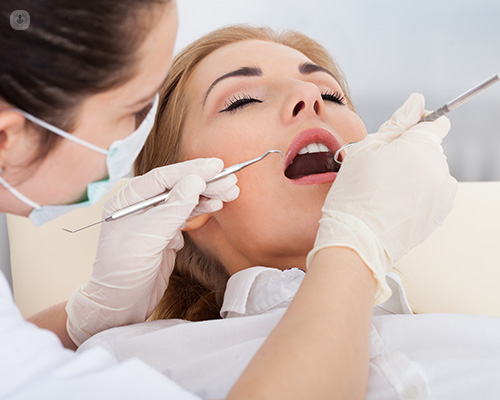Periodontal Surgery
What is periodontal surgery?
Periodontal surgery is the technique used to treat the tissues of the mouth affected by periodontal disease or pyorrhoea, a chronic bacterial infection that attacks the gums, ligaments and bone surrounding the tooth. Periodontal surgery allows the dentist to clean the contaminated tissue, smooth the root surfaces of the damaged dental piece and eliminate the pockets of infection.
Periodontal surgery can replace or rebuild damaged structures using bone-like materials and also transplant lost tissue from the gums. In this way, gums can be reattached to the base of the teeth. The surgery should be accompanied by complementary periodontal maintenance.
Periodontal surgery refers to surgery around the teeth and below the gum line. The surgery is usually carried out to remove plaque and tartar from the tooth and below the gums, and to treat other diseases and infections of the teeth such as periodontitis and periodontal disease, an aggressive infection that destroys the structures of the teeth and causes tooth loss.

What is the procedure for periodontal surgery?
The purpose of periodontal surgery is to remove bacteria from below the gums, reshape the bones that support the teeth and to prevent further gum damage.
Periodontal surgery is performed by a dentist or oral surgeon, and is usually performed under general anaesthetic, though a sedative may be used. There are a number of different surgical procedures to choose from:
Gingival flap surgery
Gingival flap surgery is more commonly used for patients who have had periodontitis, and is used to eliminate periodontal pockets. The gum would be cut to separate it from the teeth, the teeth below the gum line would then be cleaned using ultrasound equipment and manual tools, the gum is then sutured into place in the correct position.
Gingivectomy
Excess gum tissue is removed from the teeth in cases where the gums begin to overgrow the teeth. The teeth and gums are numbed and excess gum is cut away.
Bone grafting
If the supporting bone structure has been damaged by gum disease, causing the teeth to become loose or unstable, then a bone graft may be required. The graft material may be taken from your own bones, be created from synthetic bone, or may be donated bone. Following the graft, natural bone growth is promoted and the teeth will become more stable.
Soft tissue grafts
If the gums begin to recede, donor tissue can be taken, or existing tissue from the patient’s roof of their mouth may be used and grafted into position to replace the missing or retracted gum.
Guided tissue regeneration
Small pieces of tissue, taken from elsewhere in the patient are placed between the bone and the gum tissue. This will promote tissue regrowth of healthy gums when the gums have receded or been damaged by disease.
After periodontal surgery
Following periodontal surgery, the recovery depends on the severity of the disease and the type of surgery performed. Bleeding and discomfort are likely following surgery, though normal activity should be possible within a day or two of the surgery.
You may be required to eat soft foods for one or two weeks following periodontal surgery, and it may be recommended to avoid hot drinks.








